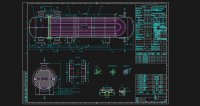新型冷却器设计(含CAD图)

新型冷却器设计(含CAD图)(任务书,开题报告,论文说明书12000字,CAD图纸6张)
摘 要
冷凝器是工业生产部门中重要的换热设备之一。换热器作为热量传递中的过程设备,在化工、冶金、石油等工业领域中应用极为广泛。换热器性能的好坏,直接影响着能源利用和转换的效率。近年来,节能工作开始被全球所重视,而换热器特别是高效换热器又是节能措施中关键的设备。因此,无论是从工业的发展角度,还是从能源的有效利用,换热器的合理设计、制造、选型和运行都有非常重要的意义。
本设计是关于固定管板冷凝器的设计。主要内容是进行了冷凝器的工艺计算,结构设计和强度校核。设计内容首先是根据根据设计条件计算换热面积。其次是结构设计以确定各部件的尺寸。最后还包括是强度计算与校核,主要包括管箱结构与管板校核和支坐的校核。
关键词:管板式换热器 冷凝器 安全 传热
Abstract
Condenser is important industrial production sector exchanger equipment. As the heat transfer in the heat exchanger process equipment, chemical industry, metallurgy, oil and other industrial applications in the field is extremely broad. Heat exchanger performance has a direct impact on energy use and conversion efficiency. In recent years, energy conservation work began to be valued by the world, but especially in the heat exchanger efficiency heat exchanger is also energy-saving measures in critical equipment. So, whether it is from industrial development perspective or from the efficient use of energy, heat exchanger rational design, manufacture, selection and operation has a very important significance.
This design is on the fixed tube plate condenser design. Main contents were calculated condenser technology, structural design and strength check. The first is the design content calculated based on the heat transfer area under design conditions. Second, the structural design in order to determine the dimensions of the various components. Also included is the strength of the final calculation and checking, including pipe and tube plate check box structure and branched sit checked.
Keywords: tube heat exchanger;Condenser;Security;Heat Transfer
1.2.6设计参数
工作压力(壳程/管程):-0.08/0.55MPa
设计压力(壳程/管程):-0.01/0.6
工作温度(壳程/管程):45℃/ 40℃
设计温度(壳程/管程): 75/65℃
腐蚀裕量(壳程/管程):0 /1mm
[版权所有:http://DOC163.com]




目 录
摘要…………………………………………………………………………………I [资料来源:http://Doc163.com]
ABSTRACT………………………………………………………………………II
第一章 绪论……………………………………………………………………… 1
1.1 常用的冷凝器…………………………………………………………………1
1.2 冷凝器的设计…………………………………………………………………2
1.2.1 冷凝器的选型……………………………………………………………2 [资料来源:http://www.doc163.com]
1.2.2 压力容器设计方法选择…………………………………………………3
1.2.3 冷热流体的管壳程分配…………………………………………………3
1.2.4 冷凝器流程的选择………………………………………………………4
1.2.5 冷凝器材料的选择………………………………………………………4
1.2.6 设计参数…………………………………………………………………4 [资料来源:https://www.doc163.com]
1.3 常见冷凝器的换热特点………………………………………………………4
1.4 压力容器的安全………………………………………………………………5
第二章 设计与制造………………………………………………………………6
2.1 原始数据………………………………………………………………………6
2.2 详细计算………………………………………………………………………6 [来源:http://www.doc163.com]
2.2.1初算换热面积及换热管数目……………………………………………6
2.2.2传热面积核算……………………………………………………………8
2.3 详细结构设计…………………………………………………………………11
2.3.1 管程结构设计……………………………………………………………11
2.3.2 壳程结构设计……………………………………………………………11
2.3.3 壳体厚度设计计算………………………………………………………12
2.3.4 封头厚度设计计算………………………………………………………13
2.3.5 前端平盖厚度计算………………………………………………………14
2.3.6 管板厚度设计计算………………………………………………………15
2.3.6.1 符号说明…………………………………………………………15 [资料来源:Doc163.com]
2.3.6.2 厚度计算…………………………………………………………15
2.4 开孔补强设计和压力试验……………………………………………………20
2.4.1 a ,b接管的开孔补强计算………………………………………………20
2.4.2 d 接管的补强计算………………………………………………………23
2.4.3 压力试验…………………………………………………………………26
2.4.3.1压力试验的目的…………………………………………………26 [资料来源:http://doc163.com]
2.4.3.2水压试验压力及应力校核计算…………………………………26
2.5 支座的设计和选型……………………………………………………………27
2.5.1 支座的分类………………………………………………………………27
2.5.2 支座的选型………………………………………………………………28
第三章 制造和维护……………………………………………………………… 30 [来源:http://Doc163.com]
3.1 制造、检验……………………………………………………………………30
3.1.1 筒体………………………………………………………………………30
3.1.2 换热管……………………………………………………………………30
3.1.3 管板………………………………………………………………………30
3.1.4 支持板……………………………………………………………………30 [资料来源:http://doc163.com]
3.1.5 管束的组装………………………………………………………………31
3.1.6 换热器的组装……………………………………………………………31
3.1.7 压力试验…………………………………………………………………31
3.2 安装与维护……………………………………………………………………31
3.2.1 安装………………………………………………………………………31 [资料来源:Doc163.com]
3.2.2 维护………………………………………………………………………32
总结与展望………………………………………………………………………… 33
参考文献…………………………………………………………………………… 34
致谢……………………………………………………………………………………36
附录……………………………………………………………………………………37
